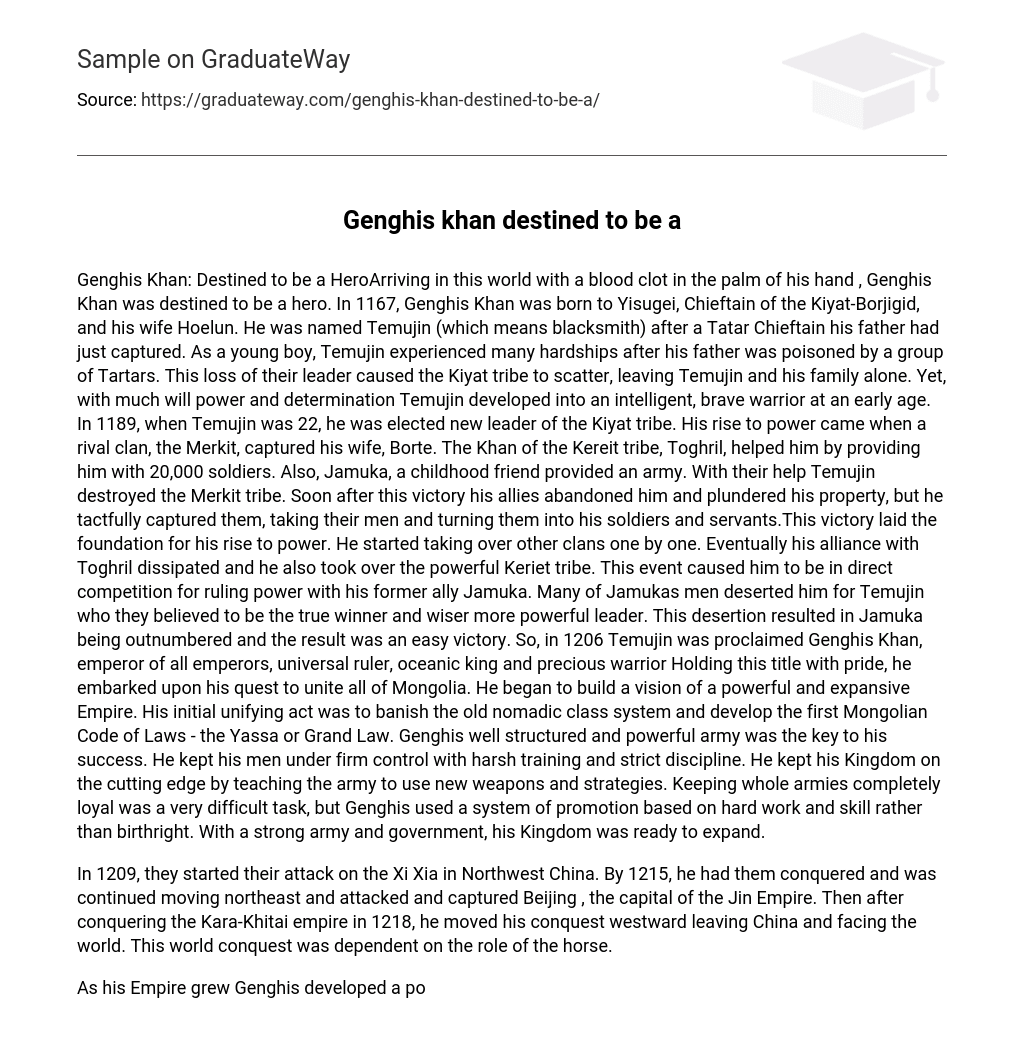Genghis Khan: Destined to be a HeroArriving in this world with a blood clot in the palm of his hand , Genghis Khan was destined to be a hero. In 1167, Genghis Khan was born to Yisugei, Chieftain of the Kiyat-Borjigid, and his wife Hoelun. He was named Temujin (which means blacksmith) after a Tatar Chieftain his father had just captured. As a young boy, Temujin experienced many hardships after his father was poisoned by a group of Tartars. This loss of their leader caused the Kiyat tribe to scatter, leaving Temujin and his family alone. Yet, with much will power and determination Temujin developed into an intelligent, brave warrior at an early age. In 1189, when Temujin was 22, he was elected new leader of the Kiyat tribe. His rise to power came when a rival clan, the Merkit, captured his wife, Borte. The Khan of the Kereit tribe, Toghril, helped him by providing him with 20,000 soldiers. Also, Jamuka, a childhood friend provided an army. With their help Temujin destroyed the Merkit tribe. Soon after this victory his allies abandoned him and plundered his property, but he tactfully captured them, taking their men and turning them into his soldiers and servants.This victory laid the foundation for his rise to power. He started taking over other clans one by one. Eventually his alliance with Toghril dissipated and he also took over the powerful Keriet tribe. This event caused him to be in direct competition for ruling power with his former ally Jamuka. Many of Jamukas men deserted him for Temujin who they believed to be the true winner and wiser more powerful leader. This desertion resulted in Jamuka being outnumbered and the result was an easy victory. So, in 1206 Temujin was proclaimed Genghis Khan, emperor of all emperors, universal ruler, oceanic king and precious warrior Holding this title with pride, he embarked upon his quest to unite all of Mongolia. He began to build a vision of a powerful and expansive Empire. His initial unifying act was to banish the old nomadic class system and develop the first Mongolian Code of Laws – the Yassa or Grand Law. Genghis well structured and powerful army was the key to his success. He kept his men under firm control with harsh training and strict discipline. He kept his Kingdom on the cutting edge by teaching the army to use new weapons and strategies. Keeping whole armies completely loyal was a very difficult task, but Genghis used a system of promotion based on hard work and skill rather than birthright. With a strong army and government, his Kingdom was ready to expand.
In 1209, they started their attack on the Xi Xia in Northwest China. By 1215, he had them conquered and was continued moving northeast and attacked and captured Beijing , the capital of the Jin Empire. Then after conquering the Kara-Khitai empire in 1218, he moved his conquest westward leaving China and facing the world. This world conquest was dependent on the role of the horse.
As his Empire grew Genghis developed a pony express system, the Yam. This network of horse messengers carried information over hundreds of routes, a thousand miles in every direction. The Mongols valued horseback riding skills realizing that speedy, dependable transportation would create a system to unite the great Empire that eventually reached from China to the edge of the Danube. To cover the great distances, the horses and their riders were required to be very hardy and self-reliant. The soldiers had to travel hard and fast for many days without supply trains to support them. The challenge of survival created a system of complete dependence on their horses. Small packets of dried meat were laid under the saddles to soften, and rations of mares milk butter were kept in the mens jackets. The men lived in filth, rarely bathing or ever changing their clothes. It has been said that a Mongol army could be smelled from 20 miles away. Each man had about five horses and a herd of remounts always followed the armies to ensure that there would be a sufficient amount of horses. Fresh mounts allowed men to travel faster. They usually covered over 80 miles a day. The horses also provided available fresh meat and their blood was boiled over a fire making a thick, black pudding. Also, when marching for days, the men responded to the lack of water by cutting a vein in the horses neck and drinking the blood. In 1220, Genghis and his hordes crushed the kingdom of Krorezm which is present day Uzebekistan and Turkmenistan, and the cities of Bukhara and Samarkand in present day Iran. The Kipchaks fell to them in 1223 along with some Russians at the Kalka River. In 17 years, Genghis Khan established an Empire superior in strength and achievement to Alexander the Great, Julius Caesar, or Hannibal. In 1225, he started war with Yi Yia. This was a war that he would not finish. August 18, 1227 Genghis Khan died at the age of 60 and was buried in a secret location somewhere in Mongolia. His children were left with the challenge of winning the war with Yi Yia. His Empire remained organized, divided between his four sons. If Historians could unclench the fist of the long departed Genghis Khan, they would still find the blood clot in his palm. He was the hero who established the Mongol rule that brought relative peaceto Asia. This peace created a world ready to be discovered by explorers such as Marco Polo.





